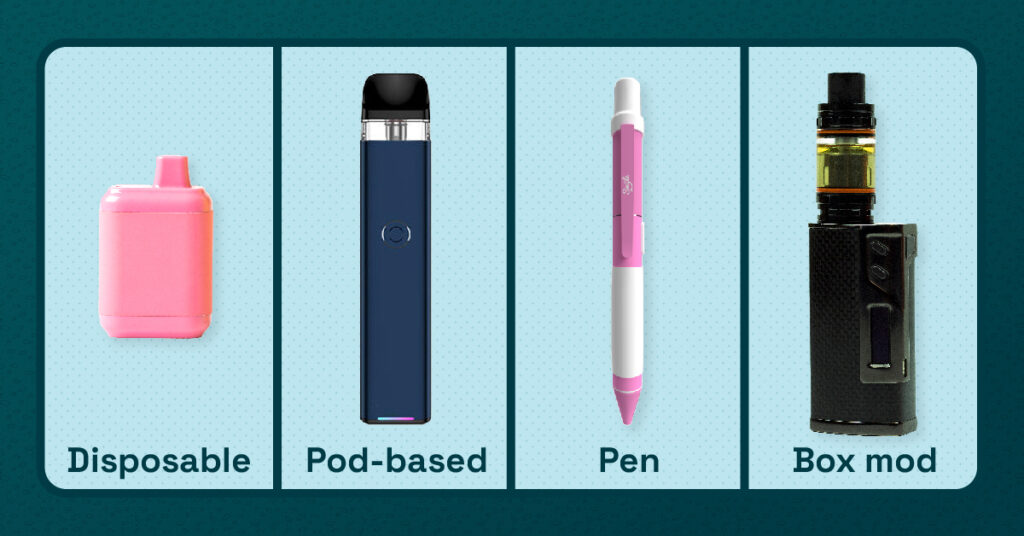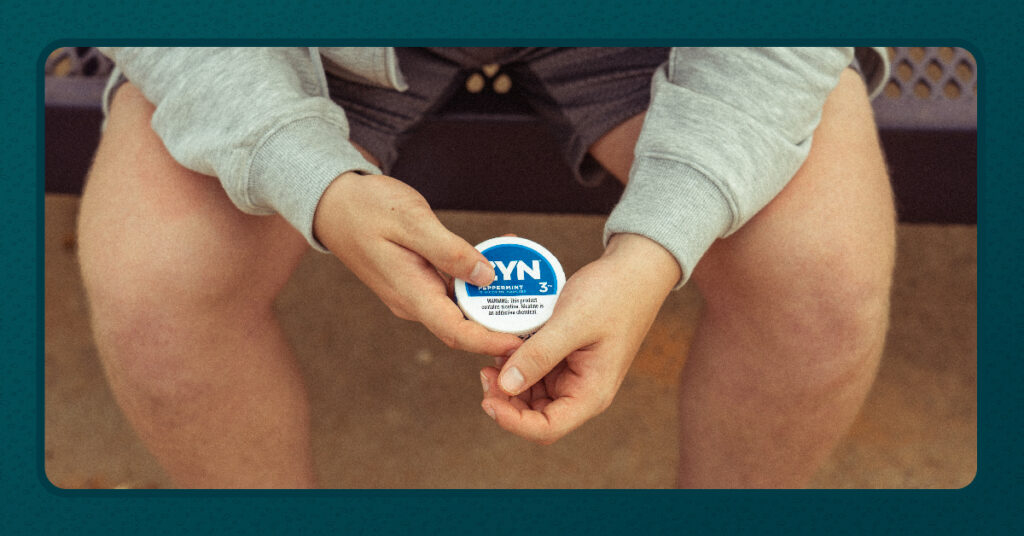Ultimate Guide to Vaping
Parents’ Guide to Vaping
Your kids face big decisions earlier than you think. Even kids as young as 11 report vaping, and over 60% of parents whose teens vape have no idea. In what feels like the blink of an eye, sleek and colorful devices start popping up everywhere, from social media to television, all targeting your children.
If you’re a parent, educator or mentor, you’re probably feeling the pressure to protect your loved ones, and you probably have a lot of questions. What’s in a vape? Why are they so popular? How are kids getting them? And most importantly, should I be worried? Don’t stress — we’ve got you covered. In this guide, we break down vaping, why it’s got such a grip on kids and what you can do to keep the teens in your life safe and healthy. Here’s the ultimate parents’ guide to vaping.
Facts on Vaping
Health Risks of Vaping
- What are the long-term health risks of vaping?
- What are the immediate health risks of vaping?
- Does vaping affect teens’ mental health?
What To Look For
- What do vapes look like?
- What are the physical signs of vaping?
- Does vaping affect teens’ behaviors?
Other Nicotine Products:
- Are teens using smokeless tobacco?
- Are cigarettes still a concern among teens?
- Should I be concerned about other products?
How To Take Action

Facts on Vaping
Parents’ Guide to Vaping: What is vaping?
Unlike traditional cigarettes that burn tobacco, vapes use batteries to heat the e-liquid (or e-juice) that typically contains nicotine and other chemicals. This process creates the vapor that gives vaping its name and presents new health risks.
Parents’ Guide to Vaping: Why is vaping bad?
Many people don’t realize vapes are made and distributed by tobacco companies, and the FDA considers e-cigarettes to be tobacco products. Despite being touted as a less harmful alternative to traditional smoking, vaping poses significant health risks, especially for young people, such as:
- Addiction: Most vapes contain nicotine, which is highly addictive and especially harmful to developing brains. Historically, nicotine is derived from the tobacco plant. However, more brands are using synthetic nicotine as a selling point. Don’t be fooled by this scheme. Synthetic nicotine is just as dangerous and addictive as tobacco-derived nicotine.
- Exposure to chemicals: The aerosol from vapes can contain potentially harmful substances, including heavy metals and other cancer-causing chemicals.
- Curiosity about other products: According to the National Library of Medicine, teens who vape are nearly four times as likely to use cigarettes later in life.
Parents’ Guide to Vaping: Why are vapes so popular?
A survey conducted by the National Youth Tobacco Survey states 21.8% of Oklahoma high school students report vaping. Several factors contribute to the popularity among young people, including:
- Flavors: There are over 15,000 vape flavors on the market readily available to teens. The “basic” flavors include menthol or mint, fruit, dessert and candy, while so-called “fun flavors” feature names such as Malibu Ice, Galactic Haze, Unicorn Puke and Capricorn Breeze. Flavors make vaping more appealing to young people, disguise the smell and mask the harsh taste of nicotine. Nearly 9 out of 10 teens who vape started with a flavored product.
- Perception of safety: Many teens believe vaping is less harmful than traditional cigarettes. But for developing brains, it’s incredibly dangerous — and addictive.
- Social pressure: Vaping is often glamorized on social media and in popular teen-centric shows and music videos. As it becomes more common, teens may also feel pressure from friends and classmates.
- Marketing: The tobacco industry has no problem spending money if it means new customers. They use many tactics to hook teens, such as sponsoring major events and festivals and promising mental health benefits. Their schemes are built on lies. For example, nicotine does not help mental health; it makes the struggles worse.
- Cost: The average cost of a vape is around $5-15. This low price point is done on purpose to make them more accessible to teens.
- Curiosity and design: The novelty of vaping, combined with the sleek designs and perceived “coolness” factor, attracts curious teens. Vapes often mirror current technology trends, which make them both appealing and easy to hide.
Parents’ Guide to Vaping: Where are teens getting vapes?
Despite laws prohibiting the sale of vapes to minors, teens find various ways to get their hands on the product. Here are a few “sources” to be aware of:
- Online: Some websites have lax age-verification processes. Teens can easily lie about their age or use an age-appropriate driver’s license to buy nicotine products. Some retailers lure teens on social media by providing “discreet shipping” to conceal their vape purchases.
- Social sources: Friends, siblings or other older acquaintances may be providing the products to make a profit.
- Brick-and-mortar shops: Age restrictions only work if retailers enforce them. Unfortunately, this isn’t always the case.

Health Risks of Vaping
Parents’ Guide to Vaping: What are the long-term health risks of vaping?
Vapes are still relatively new. While research on the long-term health effects is still ongoing, several risks have already been identified:
- Respiratory issues: Long-term exposure to vaping aerosols may lead to lung damage and other complications, such as chronic obstructive pulmonary disease (COPD), increased asthma attacks and lung cancer.
- Cognitive impacts: Our brains continue to develop until age 25. Nicotine exposure during key developmental years can lead to attention, learning, mood, impulse control and memory issues.
- Addiction: Vapes quickly deliver high levels of nicotine. It only takes one vape to cause a lifelong struggle with addiction.
Parents’ Guide to Vaping: What are the immediate health risks of vaping?
The immediate health effects your teen may experience include:
- Lung irritation: Vaping may cause coughing, wheezing and shortness of breath. If your teen has asthma, it can trigger asthma attacks and other complications.
- Bad breath and dental issues: It doesn’t take much to impact your teen’s oral health. Vaping can cause bad breath and dry mouth, eventually leading to gum disease, yellowing of the teeth and an increased risk of tooth decay.
- Nicotine poisoning: Consuming too much nicotine can lead to nausea, vomiting and upset stomach. The Centers for Disease Control and Prevention (CDC) warns that 50 to 60 milligrams of nicotine is a deadly dose for an adult who weighs about 150 pounds. The CDC also states the amount of nicotine in a single vape varies widely, but can be up to 20 milligrams — or more. These levels continue to increase each year. The risks are heightened for teens.
- Burns: Malfunctioning devices can cause burns to the mouth or hands.
Parents’ Guide to Vaping: Does vaping affect teens’ mental health?
Vaping, and especially nicotine, can have detrimental effects on teens’ mental health, such as:
- Increased anxiety and depression
- Mood swings
- Learning difficulties
- Impulsivity
It’s important to note the tobacco industry often uses mental health struggles to sell their products. This has caused many to turn to vapes as a stress reliever — 4 out of 5 youth who vape started using the products to deal with stress, anxiety or depression. However, nicotine has the opposite effect. It worsens mental health symptoms, trapping your teens in a perpetual cycle.

What To Look For
Parents’ Guide to Vaping: What do vapes look like?
Vapes come in so many different shapes and sizes. Common variations include:
- Disposable vapes: One of the most popular types of vapes, these are designed with discretion in mind. They are often stylized to resemble highlighters or other school supplies, ear-pod cases and even toys.
- Pod-based vapes: These small, often USB-shaped devices use disposable or refillable pods. You may confuse them with phone chargers, hard drives or adaptors.
- Pens: These are ultra-discreet, sleek and shaped like pens. They can hide easily in pencil bags, backpacks and desks.
- Box mods: These are the most powerful and most customizable.
Parents’ Guide to Vaping: What are the physical signs of vaping?
If you suspect your teen is vaping, be aware of these physical signs:
- Nosebleeds
- Nausea
- Frequent headaches
- Increased thirst or dehydration
- Coughing and wheezing
- Mouth sores
- Acne or skin changes
- Unexplained scents
Note: Teens’ bodies are constantly changing as they age and grow. If your teen is exhibiting one or more of these symptoms, don’t immediately assume they’re vaping. Talk with them before making accusations.
Parents’ Guide to Vaping: Does vaping affect teens’ behaviors?
Vaping can lead to behavioral changes, such as:
- Changes in sleep patterns
- Decreased interest in hobbies and sports
- Mood swings or irritability
- Difficulty concentrating
- Academic performance decline
- Overspending
- Unusual purchases
Note: Other factors, such as hormones and academic stress, can present similar behavioral changes. If your teen is exhibiting one or more of these symptoms, talk with them before making accusations.

Other Nicotine Products
Parents’ Guide to Vaping: Are teens using smokeless tobacco?
Smokeless tobacco, including products like chewing tobacco, is still used by some teens, especially in rural areas. However, nicotine pouches — such as Zyn and on! — are rapidly taking over the market. These pouches contain high levels of nicotine.
Parents’ Guide to Vaping: Are cigarettes still a concern among teens?
While vaping has taken center stage in recent years, traditional cigarettes remain a concern for teens. Although cigarette use among youth has declined significantly over the past couple of decades, they still pose a threat.
Parents’ Guide to Vaping: Should I be concerned about other products?
Youth nicotine use in any form is unsafe. It can greatly harm developing brains and cause addiction later in life. Using any form of nicotine puts young users at a higher risk for addiction to other substances.

How To Take Action
Parents’ Guide to Vaping: What do I do if my teen is vaping?
If you suspect or find out your teen is vaping, take the following steps:
- Stay calm and nonjudgmental: Approach the situation with empathy and understanding.
- Open a dialogue: Talking with your kids about such a heavy topic, especially if you know your teen is vaping, can be scary. Turn to our conversation guides for tips on how to get started and helpful statistics. Remember to make it a dialogue, not a lecture.
- Offer help: If your teen is vaping, or using any type of nicotine product, there are resources to help your teen quit. Check out the TSET Healthy Youth Initiative for vaping and tobacco prevention and quit support, as well as other healthy resources and programs for kids of all ages.
